SplineGS
Robust Motion-Adaptive Spline for Real-Time Dynamic 3D Gaussians from Monocular Video (CVPR 2025)
SplineGS - Robust Motion-Adaptive Spline for Real-Time Dynamic 3D Gaussians from Monocular Video (CVPR 2025)
Jongmin Park, Minh-Quan Viet Bui, Juan Luis Gonzalez Bello, Jaeho Moon, Jihyong Oh, Munchurl Kim
paper :
https://arxiv.org/abs/2412.09982
project website :
https://kaist-viclab.github.io/splinegs-site/
핵심 :
- COLMAP-free :
two-stage training strategy 사용
즉, camera param.을 먼저 roughly estimate한 뒤 jointly optimize camera param. and 3DGS param.- dynamic scenes from in-the-wild monocular videos :
static 3DGS와 dynamic 3DGS의 union- dynamic 3DGS’s mean :
apply spline-based model (MAS) to each dynamic 3DGS mean (trajectories)
이 때, depthmap과 camera param.를 이용해 2D track을 unproject하여 3D mean trajectories 초기화- thousands time faster than SOTA :
more efficient than MLP-based or grid-based- loss :
RGB image recon. loss
depth recon. loss
2D projection alignment loss
3D alignment loss
motion mask loss
Contribution

- novelty :
- Motion-Adaptive Spline (MAS) :
continuous dynamic3DGS trajectories(deformation) 을 효율적으로 모델링하기 위해
cubic Hermite splineswith a small number of control points 사용- control point :
- learnable param.
- determines each piecewise cubic func.’s curvature and direction
- initialization :
2D track을depthmap이용하여 3D로 unproject
- control point :
- Motion-Adaptive Control points Pruning (MACP) :
quality, efficiency 모두 챙기기 위해 계속control points를 prune하여 수 조절 - joint optimization strategy :
photometric and geometric consistencyloss 이용해서
(external estimators 필요 X)
camera param.와3DGS param.를 jointly optimize
(COLMAP-free!)
- Motion-Adaptive Spline (MAS) :
Related Works
- dynamic novel-view-synthesis :
- implicit representation (
MLP) 이용하여 deformation 모델링 in canonical space[1] ,[2] ,[3] ,[4] ,[5] - 단점 : 아무리 tiny MLP더라도 computational
overheadand low speed
- 단점 : 아무리 tiny MLP더라도 computational
- 4D space-time domain을
multiple 2D planes로 decompose하는 grid-based model[6] , 4DGS,[7] ,[8] - 단점 : grid representation으로는 scene의 dynamic 특징의
fine detail을 fully capture할 수 없음
- 단점 : grid representation으로는 scene의 dynamic 특징의
-
polynomial trajectories적용[9] - 장점 : efficient (low cost)
- 단점 : polynomial trajectory의
fixed degree는 complex motion을 표현하는 flexibility 측면에서 제한적임
- implicit representation (
- spline :
- minimal number of control points로 complex shape를 smooth and continuous representation으로 표현할 수 있음
- SplineGS (본 논문) :
- 논문
[10] ,[11] 에서처럼
각각 static bg와 moving object를 표현하기 위해
3DGS를static 3DGS와 dynamic 3DGS의 union으로 확장- static region :
diffuse and specular features는 보존한 채
time-encoded feature는 제거 - dynamic region :
mean \(\mu_{i}\) 는 deformation modeling에 의해 결정되는 time-dependent var.
rotation \(q_{i}\) 와 scale \(s_{i}\) 도 time-dependent var.
- static region :
- 논문 STGS에서처럼
final pixelcolor를 예측할 때 splatted feature rendering 사용 (SH coeff. 대신 feature!)
- 논문
Method
Architecture
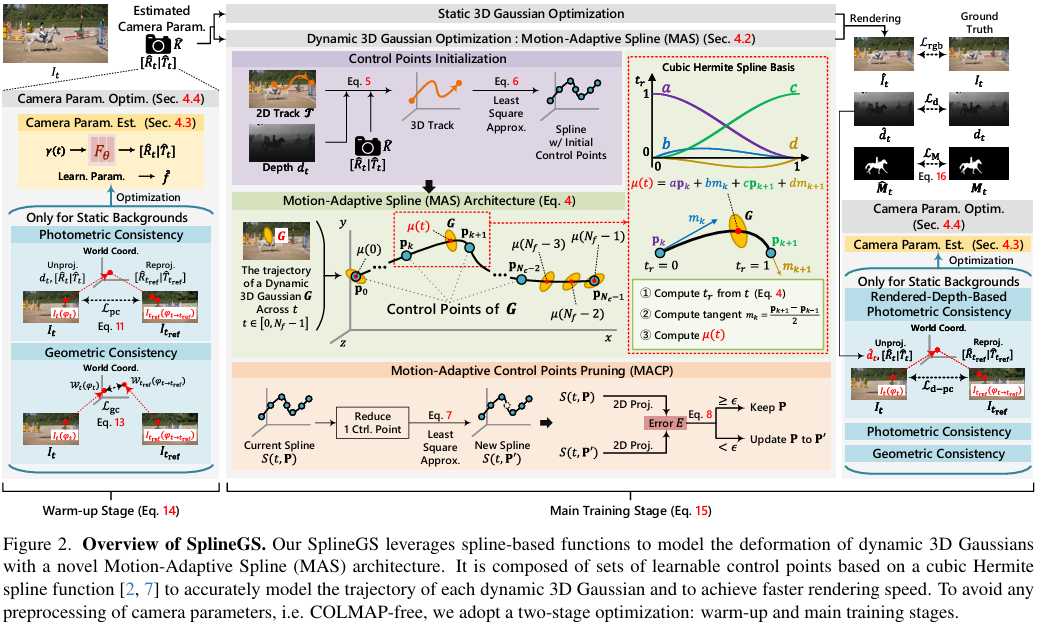
- goal :
jointly optimize 3DGS param. and camera param.- camera param. :
extrinsic \([\hat R_{t} | \hat T_{t}] \in R^{3 \times 4}\) for each time \(t\)
and shared intrinsic \(\hat K \in R^{3 \times 3}\) across all \(t\) - how :
two-stage optimization
(warm-up stage and main traning stage)-
warm-up stage:
optimizecoarse camera param.
using photometric and geometric consistency
(SfM 사용하지 않기 위해!) -
main training stage:
initialize 3DGS based on the estimated camera poses
and
jointly optimize 3DGS param. and camera param. with MAS and MACP
-
- camera param. :
Motion-Adaptive Spline for 3DGS
time \(t\) 에서 each dynamic 3DGS의 mean \(\mu(t)\) (continuous trajectory)를 모델링하기 위해
cubic Hermite spline function with a set of learnable control points 사용 (MAS)
즉, each dynamic Gaussian마다 a set of control points가 있고 얘네들의 spline curve로 Gaussian mean \(\mu(t)\) 을 결정!
- Motion-Adaptive Spline (
MAS) :
\(\mu(t) = S(t, \boldsymbol P)\)- input :
- time \(t\)
- a set of \(N_{c}\) learnable control points
\(\boldsymbol P = \{ \boldsymbol p_{k} | \boldsymbol p_{k} \in R^{3} \}\) where \(k \in [0, N_{c}-1]\)
- piece-wise cubic Hermite spline function \(S(\cdot)\) :
\(S(t, \boldsymbol P) = (2t_{r}^{3} - 3t_{r}^{2} + 1) \boldsymbol p_{\lfloor t_{s} \rfloor} + (t_{r}^{3} - 2t_{r}^{2} + t_{r}) \boldsymbol m_{\lfloor t_{s} \rfloor} + (-2t_{r}^{3} + 3t_{r}^{2}) \boldsymbol p_{\lfloor t_{s} \rfloor + 1} + (t_{r}^{3} - t_{r}^{2}) \boldsymbol m_{\lfloor t_{s} \rfloor + 1}\)- \(N_{f}\) : frame (timestamp) 개수
- \(N_{c}\) : control point 개수 (estimated by MACP)
- \[t \in [0, N_{f} - 1]\]
- \(t_{s} = t \frac{N_{c} - 1}{N_{f} - 1} \in [0, N_{c} - 1]\)
e.g. 3.7 - \(t_{r} = t_{s} - \lfloor t_{s} \rfloor\)
e.g. 0.7 - \(\boldsymbol m_{k} = (\boldsymbol p_{k+1} - \boldsymbol p_{k-1})/2\) : approx. tangent(기울기) of control point \(\boldsymbol p_{k}\)
-
piece-wise cubic Hermite spline function:
\(\lfloor t_{s} \rfloor = 3\) 에서의 control point 및 tangent와
\(\lfloor t_{s} \rfloor + 1 = 4\) 에서의 control point 및 tangent와
그 사이 어디쯤 있는지 \(t_{r} = 0.7\) 를 이용하여
\(\lfloor t_{s} \rfloor = 3\) 과 \(\lfloor t_{s} \rfloor + 1 = 4\) 사이의 piece-wise cubic Hermite spline function을 그림
- input :
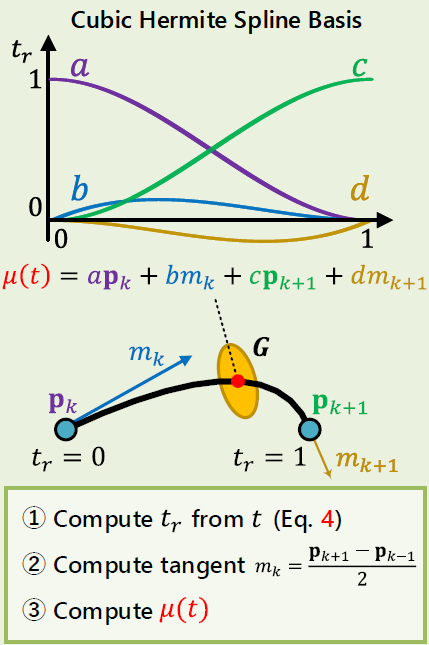

-
Initialization of 3D Control Points:
intialization은 quality에 매우 중요!
long-range2D track[12] 과depth[13] prior 사용- notation :
- 2D track by
[12] : \(\mathcal{T} = \left\{ \varphi_{t}^{tr} | \varphi_{t}^{tr} \in R^{2} \right\}_{t \in [0, N_{f} - 1]}\)
where \(\varphi_{t}^{tr}\) : 2D track on pixel-coordinate at time \(t\) - projection func. from 3D camera-space to 2D image-space by intrinsic \(K\) : \(\pi_{K}(\cdot)\)
- 2D track by
- Step 1)
unproject 2D track\(\mathcal{T}\) on image-space into 3D track curve on world-space
usingdepth\(d_{t}\) and coarsely-estimatedcamera param.\(\hat K, [\hat R_{t} | \hat T_{t}]\)
\(W_{t}(\varphi_{t}^{tr}) = \hat R_{t}^{T} \pi_{\hat K}^{-1}(\varphi_{t}^{tr}, d_{t}(\varphi_{t}^{tr})) - \hat R_{t}^{T} \hat T_{t}\)- we estimate camera param. \(\hat K, \hat R, \hat T\) from only frames (without any GT)
- Step 2)
initialize per-Gaussian control points set \(\boldsymbol P\)
by least-square approx. s.t.spline curve\(S(t, \boldsymbol P)\) fits the initialtracker curve\(W_{t}(\varphi_{t}^{tr})\)
\(\text{min}_{\boldsymbol P} \sum_{t=0}^{N_{f} - 1} \| W_{t}(\varphi_{t}^{tr}) - S(t, \boldsymbol P) \|^{2}\)
- notation :

- Motion-Adaptive Control Points Pruning (
MACP) :- issue :
- control points 수가 너무 많으면
spline curve가 over-fitting되고 speed가 느려짐 - scene마다 motion의 종류와 정도가 각기 다르므로
control points 수 for each dynamic 3DGS 는 scene에 맞춰서 need to be adaptively adjusted
- control points 수가 너무 많으면
- solution :
sparser control points로 prune하기 위해
every 3DGS densification이 끝날 때마다new spline function \(\mu(t) = S(t, \boldsymbol P')\) 계산
where \(\boldsymbol P' = \left\{ \boldsymbol p_{l}' | \boldsymbol p_{l}' \in R^{3} \right\}_{l \in [0, N_{c} - 2]}\) : a set of \(N_{c} - 1\) control points
(current set \(\boldsymbol P\) 보다 control point 1개 더 적음) - Step 1)
1개 적은 control point set으로도 최대한 비슷한 spline curve를 만들도록 least-square approx.
\(\text{min}_{\boldsymbol P'} \sum_{t=0}^{N_{f}-1} \| S(t, \boldsymbol P) - S(t, \boldsymbol P') \|^{2}\) - Step 2)
\(S(t, \boldsymbol P)\) 와 \(S(t, \boldsymbol P')\) 간의 error \(E\) 가 작을 때만 a set of control points 업데이트
\(\boldsymbol P = \begin{cases} \boldsymbol P' & \text{if} & E \lt \epsilon \\ \boldsymbol P & O.W. \end{cases}\)
where error \(E = \frac{1}{N_{f}} \sum_{t=0}^{N_{f} - 1} \| \pi_{\hat K}(\hat R_{t} S(t, \boldsymbol P) + \hat T_{t}) - \pi_{\hat K} (\hat R_{t} S(t, \boldsymbol P') + \hat T_{t} \|^{2}\)
(각 timestamp \(t\) 에서3D mean on spline curve를 2D로 project시킨 뒤 차이비교) - 의의 :
each dynamic 3DGS마다 a set of control points를 따로 가지고 있는데,
MACP 덕분에 각 dynamic 3DGS가 각기 다른 수의 control points를 가질 수 있고,
motion이 복잡한 part는 control points 수가 많고
motion이 단순한 part는 control poitns 수가 적은방식으로
scene에 adaptively adjust 가능
- issue :
Camera Pose Estimation
- Camera Pose :
-
extrinsic:
\([\hat R_{t} | \hat T_{t}] = F_{\theta}(\gamma(t))\)- extrinsic 은
time에 대한 function - notation :
- \(\gamma(\cdot)\) : positional encoding
- \(F_{\theta}\) : shallow MLP
- extrinsic 은
- intrinsic (
focal length) :- focal length \(\hat f\) 는 learnable param.
shared across all framesin monocular video
- focal length \(\hat f\) 는 learnable param.
-
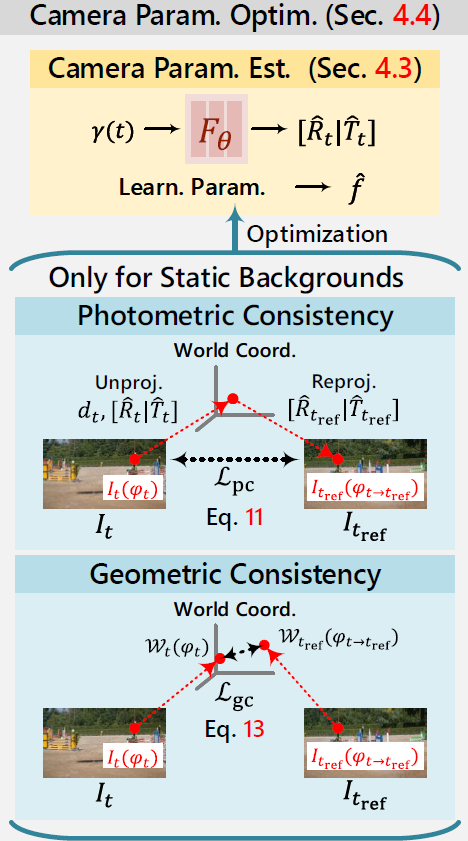
- Loss for optimizing Camera Pose :
- Loss 1)
photometric consistency:projection alignment- 목적 :
target frame \(t\) 의 pixel \(i\) 가 reference frame \(t_{ref}\) 의 pixel \(j\) 로 projection 되었을 때
reference frame’s pixel \(j\) 의 color \(I_{t_{ref}}(\varphi_{t \rightarrow t_{ref}})\) 가
target frame’s pixel \(i\) 의 color \(I_{t}(\varphi_{t})\) 와 일치하도록 - notation :
- \(\varphi_{t}\) : target frame’s pixel-coordinate
- \(\varphi_{t \rightarrow t_{ref}} = \pi_{\hat K} (\hat R_{t_{ref}} (\hat R_{t}^{T} \pi_{\hat K}^{-1} (\varphi_{t}, d_{t}(\varphi_{t})) - \hat R_{t}^{T} \hat T_{t}) + \hat T_{t_{ref}})\) : reference frame’s pixel-coordinate corresponding to \(\varphi_{t}\)
(2D target frame \(t\)’s pixel-coordinate \(\rightarrow\) 3D location world-coordinate \(\rightarrow\) 2D reference frame \(t_{ref}\)’s pixel-coordinate)
- loss :
\(L_{pc} = \sum_{\varphi_{t}} \| M_{t, t_{ref}}(\varphi_{t}) \circledast (I_{t}(\varphi_{t}) - I_{t_{ref}}(\varphi_{t \rightarrow t_{ref}})) \|^{2}\)- \(M_{t, t_{ref}} = M_{t}(\varphi_{t}) M_{t_{ref}}(\varphi_{t \rightarrow t_{ref}})\) : union motion mask
(dynamic objects는 color 변하는 게 당연하니까 제거하고, static region에 대해서만 loss 걸어줌)
(\(M_{t}\) 와 \(M_{t_{ref}}\) 는 각각 \(I_{t}\) 와 \(I_{t_{ref}}\) 로부터 미리 계산한 motion mask[14] )
- \(M_{t, t_{ref}} = M_{t}(\varphi_{t}) M_{t_{ref}}(\varphi_{t \rightarrow t_{ref}})\) : union motion mask
- 목적 :
- Loss 2)
geometric consistency:3D alignment- 목적 :
target frame \(t\) 의 pixel \(i\) 가 reference frame \(t_{ref}\) 의 pixel \(j\) 로 projection 되었을 때
reference frame’s pixel \(j\) 를 3D location on world-coordinate으로 unproject시킨 \(W_{t_{ref}}(\varphi_{t \rightarrow t_{ref}})\) 가
target frame’s pixel \(i\) 를 3D location on world-coordinate으로 unproject시킨 \(W_{t}(\varphi_{t})\) 와 일치하도록 - notation :
- \(W_{t}(\varphi_{t}) = \hat R_{t}^{T} \pi_{\hat K}^{-1}(\varphi_{t}, d_{t}(\varphi_{t})) - \hat R_{t}^{T} \hat T_{t}\) : unproject from pixel-coordinate to 3D world-coordinate
- loss :
\(L_{gc} = \sum_{\varphi_{t}} \| M_{t, t_{ref}}(\varphi_{t}) \circledast (W_{t}(\varphi_{t}) - W_{t_{ref}}(\varphi_{t \rightarrow t_{ref}})) \|^{2}\)
- 목적 :
- Loss 1)
Loss
- Two-stage Optimization :
- Stage 1) warm-up stage
- optimize
only camera param. - loss :
\(L_{total}^{warm} = \lambda_{pc} L_{pc} + \lambda_{gc} L_{gc}\)- \(L_{pc}\) : photometric consistency (projection alignment)
- \(L_{gc}\) : geometric consistency (3D alignment)
- optimize
- Stage 2) main training stage
- Step 2-1)
Stage 1)에서 coarsely 예측한 camera param. \(\hat K, \hat R, \hat T\) 를 이용하여
각 dynamic 3DGS의a set of control points 초기화
(how? : 위의 Motion-Adaptive Spline for 3DGS 섹션에서 설명함) - Step 2-2)
jointly optimize 3DGS param. and camera param. - loss :
\(L_{total}^{main} = \lambda_{rgb} L_{rgb} + \lambda_{d} L_{d} + \lambda_{M} L_{M} + \lambda_{pc} L_{pc} + \lambda_{d-pc} L_{d-pc} + \lambda_{gc} L_{gc}\)-
recon. loss:- \(L_{rgb}\) : L1 recon. loss b.w. rendered frame and GT frame
- \(L_{d}\) : L1 recon. loss b.w. rendered depth and GT depth
-
alignment loss:- \(L_{pc}\) : photometric consistency (projection alignment)
- \(L_{gc}\) : geometric consistency (3D alignment)
- \(L_{d-pc}\) : additional photometric consistency (projection alignment)
-
prior depth[13] 대신3DGS를 이용한rendered depth사용하여
photometric consistency 계산 - prior depth 대신 rendered depth를 사용하면
estimated 3DGS geometry 의 도움을 받아
joint optimization of camera param. and 3DGS param. 가능!
-
-
motion mask loss:- \(L_{M} = 1 - \text{f1-score} = 1 - \frac{2(\sum_{\varphi_{t}} M_{t}(\varphi_{t}) \hat M_{t}(\varphi_{t})) + \epsilon}{(\sum_{\varphi_{t}} M_{t}(\varphi_{t}) + \hat M_{t}(\varphi_{t})) + \epsilon}\) : binary dice loss
b.w.pre-computed GT motion mask\(M_{t}\) from prior[14]
andrendered motion mask\(\hat M_{t}\) from dynamic 3D Gaussians- rendered motion mask :
\(\hat M_{t}(\varphi_{t}) = \sum_{i \in N} m_{i} \alpha_{i} \prod_{j=1}^{i-1} (1 - \alpha_{j})\)
where \(m_{i} = 0\) if \(i\)-th 3DGS is static 3DGS, and \(m_{i} = 1\) if \(i\)-th 3DGS is dynamic 3DGS
(즉, \(i\)-th 3DGS가 static인지, dynamic인지에 따른 \(m_{i}\) 를 accumulate 하여 motion mask로 rendering!)
- rendered motion mask :
- binary dice loss는 highly imbalanced segmentation을 위해 제안되었듯이
dynamic 3DGS와 static 3DGS를 더 잘 분리할 수 있게 해줌
- \(L_{M} = 1 - \text{f1-score} = 1 - \frac{2(\sum_{\varphi_{t}} M_{t}(\varphi_{t}) \hat M_{t}(\varphi_{t})) + \epsilon}{(\sum_{\varphi_{t}} M_{t}(\varphi_{t}) + \hat M_{t}(\varphi_{t})) + \epsilon}\) : binary dice loss
-
- Step 2-1)
- Stage 1) warm-up stage
Experiment
- Dataset :
- NVIDIA dataset
- evaluation configuration :
[RoDynRF] 를 따름 - dataset sampling :
[NSFF] 를 따름- sample 24 timestamps
- larger motion을 simulate하기 위해
홀수 frames 제외 - generalization을 위해
test 시에 사용할 timestamps를 training할 때 제외
- evaluation configuration :
- DAVIS dataset (avg. 70 frames per video)
- NVIDIA dataset
Result
- Novel-View-Synthesis :
- SOTA baseline :
- COLMAP-based :
[DynNeRF] ,[MonoNeRF] ,[STGS] ,[SCGS] ,[D3DGS] ,[4DGS] ,[RoDynRF] ,[CasualFVS] ,[Ex4DGS] ,[Mosca] - RoDynRF, DynNeRF : 느림
- Ex4DGS, STGS : multi-view setting으로 설계되어 monocular video로 학습하면 시간에 따라 점점 inconsistent geometry alignment
- D3DGS, STGS : SfM(COLMAP)이 DAVIS dataset에서 camera param. 및 initial pcd 잘 추정 못함
- COLMAP-free :
[RoDynRF] ,[Mosca]
- COLMAP-based :
- SOTA baseline :


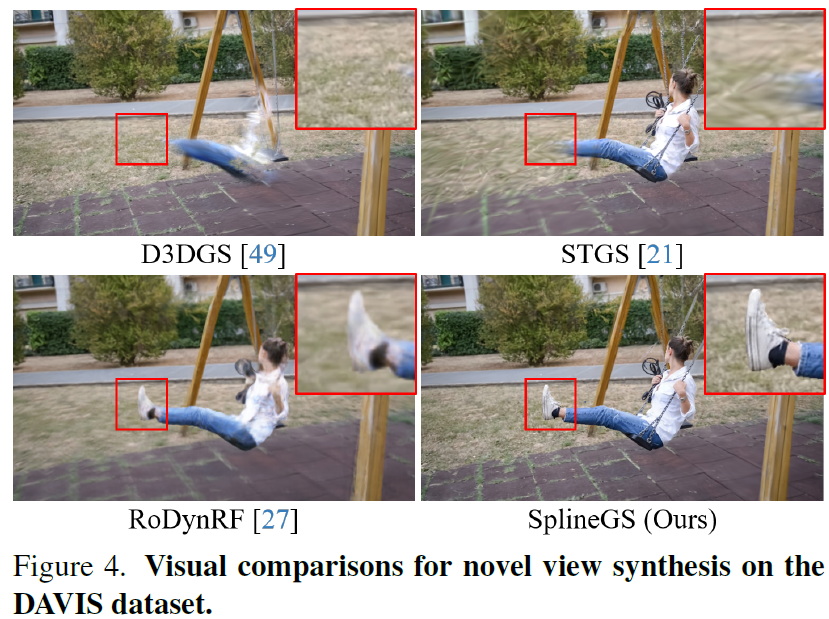
- Novel View and Time Synthesis :
- SOTA baseline :
- NeRF-based :
[DynNeRF] ,[RoDynRF] - RoDynRF, DynNeRF : unseen timestamp에 대해 artifacts 및 blurriness 생김
- 3DGS-based :
[STGS] ,[D3DGS] ,[4DGS] - STGS, D3DGS, 4DGS : unseen timestamp에 대해 더 심각한 degradation 생김
- NeRF-based :
- 본 논문 (SplineGS) :
MAS(Motion-Adaptive Spline) 덕분에
dynamic 3D Gaussian들을 효과적으로 deform시켜서
시간에 따라 움직이는 물체의 continuous trajectories를 정확히 캡처할 수 있음- unseen timestamp에 대해서도 continuous trajectory로 잘 캡처 가능
- temporal consistency는 아래의 tOF score로 확인 가능
- continuous trajectories 모델링 능력을 확인하기 위해
아래 그림에 dynamic objects의 projected 2D motion tracking 결과도 있음
- SOTA baseline :
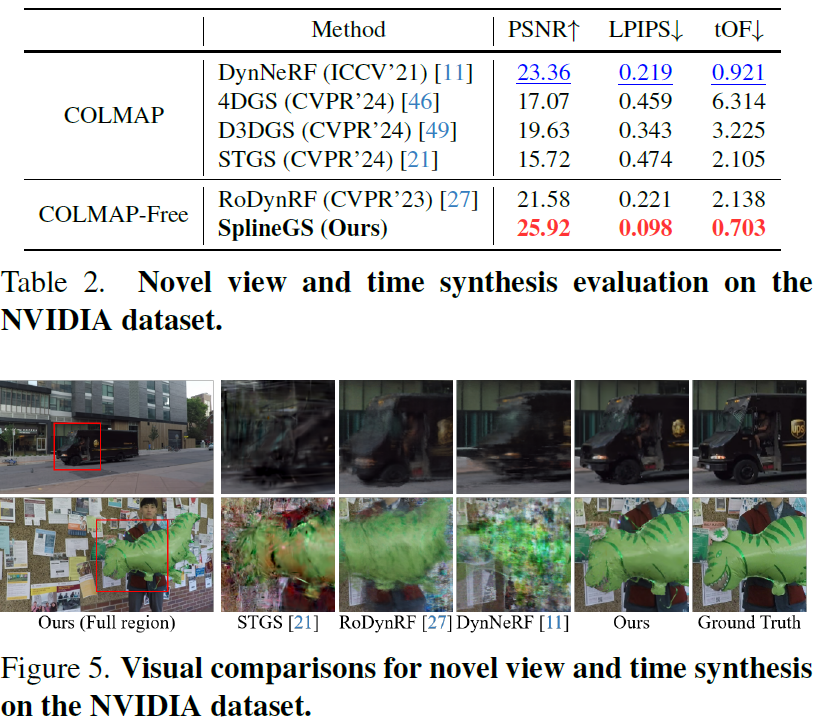
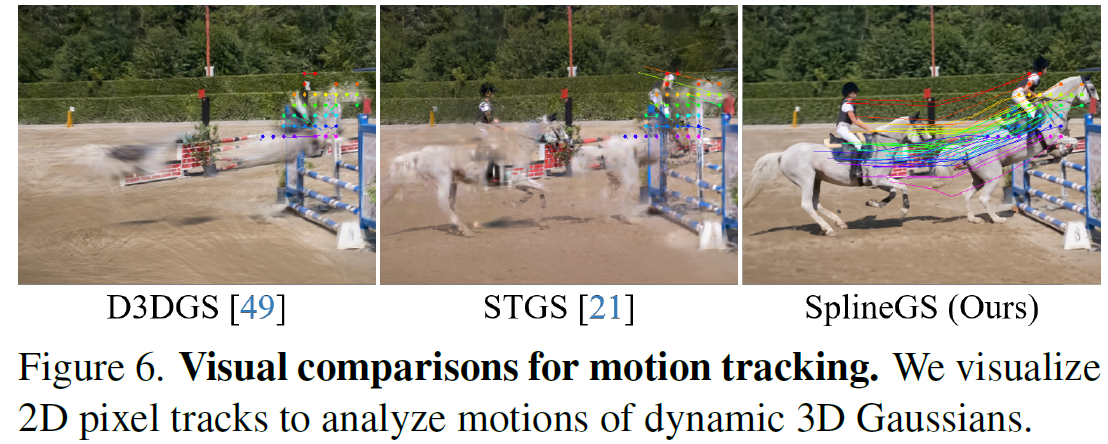
Ablation Study
- Motion-Adaptive Spline (MAS) :
- baseline : various deformation models
- MLP
e.g. D3DGS - grid-based model
e.g. 4DGS - polynomial func. of degree 3 or 10
e.g. STGS
(degree 10을 쓰면 numerical instability 때문에 noisier optimization으로 quality도 더 안 좋고, latency도 증가함) - Bezier curve
(성능 비슷하게 좋지만, recursive 계산 때문에 MAS보다 latency 큼)
- MLP
- baseline : various deformation models
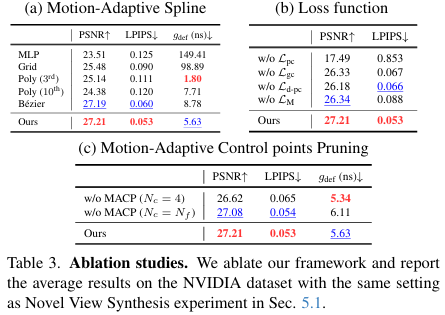
- Motion-Adaptive Control Points Pruning (MACP) :
- baseline : fixed number of control points \(N_{c} = 4\) or \(N_{c} = N_{f}\)
- MAS with MACP :
good trade-off (latency 조금 증가하지만 rendering quality 많이 증가)
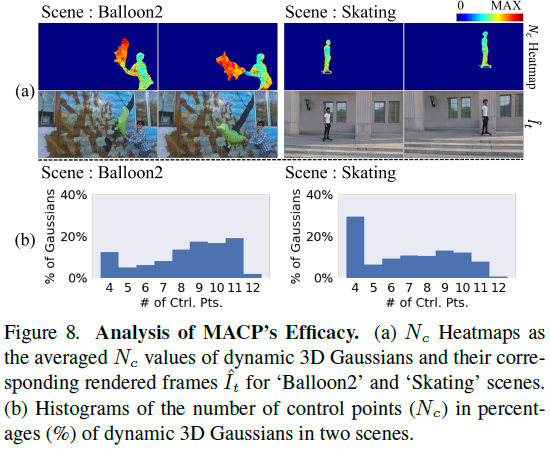
Conclusion
- Limitation :
- Prior 필요
- depthmap (for all)
- 2D track (for all)
- motion mask (for \(L_{M}\))
- in-the-wild video에서 camera 또는 object가 매우 빠르게 움직이는 경우 input frames 자체가 blurry한데,
이러한 input frames의 흐림 자체가 rendering quality를 낮춤- 현재 가능한 solution :
SOTA 2D deblurring methods를 pre-processing으로 먼저 input frames에 적용한 뒤 training에 사용 - future work :
따로 pre-processing하지 않고,
deblurring method와 recon. pipeline을 통합하여
joint deblurring and rendering optimization framework 구축
- 현재 가능한 solution :
- per-Scene model이라 feed-forward model로 확장 가능
???
- Prior 필요
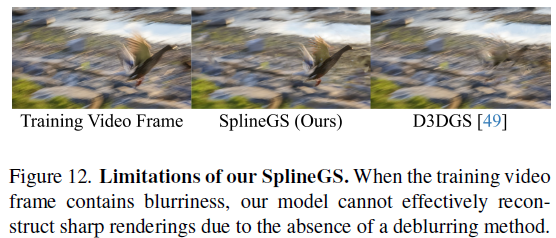
Question
-
Q1 :
photometric consistency loss에서 motion mask 값이 static region에 대해서만 0이라는데,
dynamic object를 exclude한다는 문구로 미루어보아 (static region에만 loss를 걸어주기 위해)
static region에 대해서 1이어야 하는 거 아닌가요? -
A1 :
code implementation 한 번 보자 -
Q2 :
colmap을 안 쓰면 Gaussian mean initialization은 어떻게 하나요? -
A2 :
per-Gaussian parameter로 Gaussian마다 a set of control points \(\boldsymbol P = \{ \boldsymbol p_{k} | \boldsymbol p_{k} \in R^{3} \}\) where \(k \in [0, N_{c}-1]\) 를 가지고 있고,
depth prior와 coarsely-estimated camera param.로 2D track prior를 unproject한 뒤 LS approx.로 a set of control points \(\boldsymbol P\) 를 initialize (그러면 arbitrary timestep \(t\) 에서의 Gaussian mean은 해당 spline function 위에 있게 됨) -
Q3 :
MACP로 control point를 하나 뺄 대 어떤 control point를 빼나요? -
A3 :
하나 적은 control points’ set으로 new spline function \(S(t, \boldsymbol P)\) 를 다시 만들고, control point들은 time에 대해 균등하게 배치 -
Q4 :
colmap-free라서 camera parameter를 추정한다고 할 때 요즘 논문들은 보편적으로 depth prior를 활용하여 학습을 통해 추정하나요? -
A4 :
아니요, NoPoSplat 같은 논문을 보면 depth prior 없어도 transformer가 photometric loss만으로 camera parameter 추정하기도 합니다 -
Q5 :
two-stage로 나눠서 학습을 통해 먼저 camera parameter를 추정하려면 training time이 더 오래 걸릴텐데, COLMAP pre-processing 쓰지 않고 직접 camera parameter를 추정하는 이유가 뭔가요? -
A5 :
COLMAP으로 camera pose를 pre-compute 해놓는 건 in-the-wild video에서 별로 성능 안 좋음 (특히 원형 호수 같은 images에서는 COLMAP 성능 꽝). 그래서 차라리 직접 학습을 통해 camera parameter를 추정하는 게 더 성능 좋음 -
Q6 :
dynamic NVS modeling 기법 중에 Spline-based representation이 갖는 장점은? - A6 :
- grid-based modeling - 단점 : struggle to fully capture the fine details
e.g. HexPlane, 4DGS - polynomial modeling - 단점 : fixed degree restricts flexibility for complex motions
- spline-based modeling - 장점 : explicit spline function이 continuous trajectory를 보장해서 unseen novel timestamp에 대해서도 생각보다 퀄리티 괜찮음
- grid-based modeling - 단점 : struggle to fully capture the fine details
-
Q7 :
camera parameter를 추정할 때 unproject함으로써 photometric consistency와 geometric consistency를 이용하는데,
만약에 카메라(extrinsic)가 고정된 채 scene content만 dynamic하게 움직이는 경우에는 해당 두 가지 loss가 잘 작동하지 않을 것 같습니다 - A7 :
맞는 말입니다. 하지만 dataset 중에 dynamic scene을 찍는 카메라가 움직이지 않는 경우는 거의 없고, camera movement가 작은 DAVIS data가 있긴 한데 거기서도 해당 모델이 잘 작동하긴 했습니다.